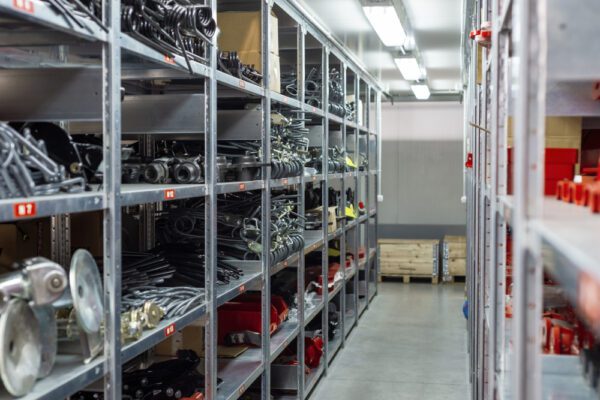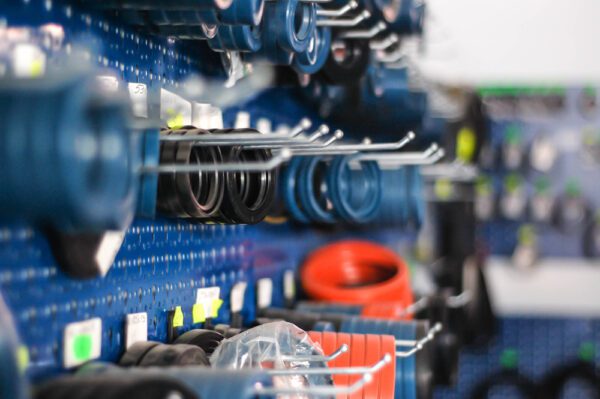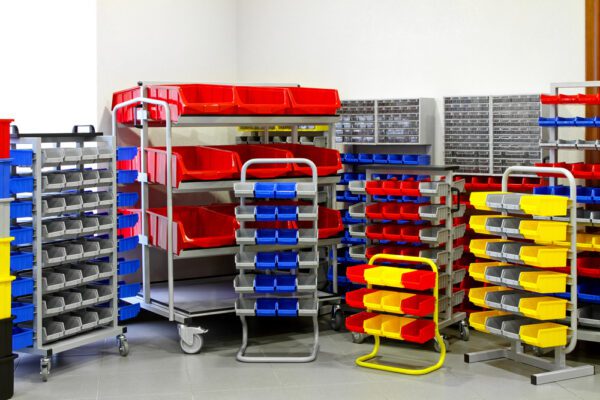
Maintenance storeroom organization greatly influences maintenance operations and the organization’s bottom line. However, maintenance storerooms are commonly disorganized, cluttered, and neglected, creating numerous inefficiencies that drive up MRO inventory costs. Though organizing your maintenance storeroom may be a long process, the benefits of improved asset reliability and productivity are well worth the effort.
Why Maintenance Storeroom Organization Matters
The organization of your maintenance storeroom greatly impacts the productivity of the maintenance team. According to a study conducted by Emerson Reliability Consulting, technicians spend 10% to 25% of their time obtaining parts. Instead of performing maintenance work, maintenance staff is spending up to a quarter of their day trying to identify and locate spare parts! Meanwhile, the organization unnecessarily loses money from lost production, extended asset downtime, and emergency inventory purchases.
An organized maintenance storeroom provides several benefits. First, it allows maintenance staff to get in and out of the storeroom quickly because everything is in its place and is easily found. This shortens the amount of time it takes for technicians to respond to unplanned maintenance events, reducing downtime.
Better part location also reduces the need for workers to create their own “private” inventories in personal toolboxes. As a result, inventory counts become more accurate, reducing duplicate orders for parts that are in stock but cannot be found when needed.
Reduced inventory levels not only mean less inventory spend, but also that less space is needed for storage. Combined with improved storage solutions, more free space is available in the facility for additional production equipment, kitting, or other workspace.
Maintenance storeroom organizations also impacts inventory control. When storeroom clerks are able to plainly see what items are in stock and how much is on hand, they can make better decisions regarding the timing of orders, order frequency, order size, lead time, and available storage space.
Finally, better storeroom organization means that MRO items will be stored properly, protecting them from degradation caused by humidity, temperature, dust, and other environmental factors.
How to Organize Your Maintenance Storeroom
The most tried and true approach to maintenance storeroom organization is 5S, developed as part of lean manufacturing. The philosophy behind 5S is that good results cannot be achieved until a workplace is in a clean and organized state. It is estimated that the effective implementation of 5S improves maintenance efficiency by 10% – 30%. Therefore, this discussion will approach maintenance storeroom organization through the lens of 5S. For those unfamiliar with the concept of 5S, each S is defined below:
- Sort: Examine a set of items and remove those that are unnecessary or unwanted.
- Straighten / Set in Order: Determine a logical way to arrange items.
- Shine: Keep workspaces clean and well-maintained.
- Standardize: Systematize the previous steps and create standard operating procedures that make these activities routine.
- Sustain: Make 5S a part of the company’s culture.
Sort

Over time, storerooms tend to hold MRO items that are obsolete. For example, assets are often replaced or retired, leaving their associated parts behind. Organizations also switch inventory vendors in search of better prices or contract terms, resulting in out-of-date parts. Or possibly, an effort to standardize parts across equipment renders parts useless.
The goal of sort is to get rid of unnecessary items. Ideally, every item left in the storeroom is tied to operating equipment. Also consider stocked items that are not stored in the storeroom, such as spare parts managed through vendor managed inventory (VMI) agreements.
There are many valuable resources that can assist with sorting. MRO inventory management systems, if available, are used to create bills of materials (BOMs), track usage metrics, and analyze other inventory management data for decision making. Technicians and maintenance storeroom staff are also valuable resources. They work directly with the parts themselves, and can offer insight into the purpose of parts, when and how often they are used, and whether the parts are truly needed.
Straighten / Set in Order
After the sort phase, only essential items should remain. Next is to straighten or set items in place. The straighten phase is best summed up by the proverb “A place for everything and everything in its place.” This phase helps organizations locate parts and tools in the most efficient manner.
Parts Organization Methods
There are numerous ways to organize items within the storeroom. Regardless of what method is chosen, parts should be easy to find, easy to use, and easy to put away. Two common ways to organize parts are by asset or by part type and are described below. It should be noted that many organizations use a combination of organization methods.
Organize Parts by Asset
With this method, parts are organized by the asset(s) on which they are used. Organizations choose this method because it makes it easier to find the right parts for an asset, whether for planned or emergency maintenance. It is also useful when many parts are needed for the same asset at once.
A major downside of this approach is duplicity. Parts that are used on more than one piece of equipment, which is often the case, must be stored in multiple locations. Organizing inventory this way requires more precise inventory control and additional storage space.
Organize Parts by Type

This approach organizes similar parts together (i.e., bearings with bearings, fuses with fuses, etc.) and provides numerous advantages. First, it helps with troubleshooting because it makes it easy to find substitute parts if required parts are out of stock. Second, it makes it easier to measure the value of inventory part types – for example, you can see how many motors are in stock at a glance. Finally, grouping inventory parts by type reduces duplication, since parts are only stored in one location.
One potential downside to this method is the opportunity for mistakes. Technicians in a hurry are more prone to grab the wrong part, which delays response times and increases downtime costs. However, a barcoding system reduces this risk. More on this topic is discussed in the Standardization section.
Location
Straighten also means determining the best locations for parts within the maintenance storeroom. For example, commonly used parts may be placed closest to the entrance to reduce unnecessary travel. Alternatively, items commonly used together may be located near one another, like storing personal protective equipment (PPE) near hazardous chemicals.
Storage Solutions

The structures used to hold inventory items should also be considered during this phase. There are many storage solutions available, each with their own pros and cons depending on the type of inventory being held. For some companies, shelves and bins work fine. Storerooms with space limitations may consider high density cabinets.
Also consider storage locations outside of the storeroom, such as lockboxes, cribs, and other areas. These storage locations provide quick access to high volume parts without requiring technicians to travel all the way back to the storeroom, thereby increasing their productivity.
Shine
The shine stage focuses on keeping the storeroom clean and by extension, well maintained. Basic housekeeping improves storeroom safety by removing debris that leads to slips and falls. Cleaning reduces the risk of pathogens and other health hazards.
One must also pay attention to the condition of the storeroom itself. Parts stored in environments that are overly humid, hot, or cold leads to premature part degradation. For example, excess moisture in the air that collects on surfaces causes corrosion and mold. Dusty parts do not perform to specification. When combined with humidity, dust and debris stick to parts and become difficult to remove.
Take note of other storeroom conditions as well. Ensure that storage equipment is in good condition. Fix any holes in the roof, cracked or broken windows, or missing doors. Provide proper lighting and heating and air conditioning. While these tasks sound like common sense, you’d be surprised at how often they are ignored.
Standardize
After sort, straighten, and shine, your maintenance storeroom should be in pretty good shape. The standardize step makes the aforementioned activities routine so that your storeroom doesn’t slowly slip back into a state of disarray. Standardization involves creating standard operating procedures that reinforce 5S principles.
Schedules and Checklists
Create a schedule to make 5S tasks a part of your routine operations. Schedules spell out how frequently tasks like cleaning should be done and who is responsible. Also provide a chart or checklist that communicates what needs to be done. Checklists not only serve as a reminder of what to do, but can also be used to audit whether tasks are completed to satisfaction. Overtime, these tasks will become second nature and will be done automatically.
Naming Conventions
Standardized asset naming conventions help identify parts and their attributes. Technicians can use asset names to quickly locate parts within the storeroom, depending on its organization. For example, if all bearings are stored together, a technician will know which section of the storeroom to look in when a part name that includes “BRNG” appears on a work order.
Further, assign standardized names to the storeroom aisles, racks, shelves, and bins. This information directly tells workers where parts are located, such as aisle 5, rack A, shelf 1, and bin 7.
Standardization also extends to the inventory tracking system or computerized maintenance management system (CMMS). A standardized asset naming convention helps employees easily identify parts in the system, as well as provides a way for new records to be added in the future.
Labeling and Signage

Labels and signs provide employees with a quick reference of 5S expectations. Print and display maps of the storeroom to remind technicians where parts are located so they can be picked or returned. Use labels on aisles, racks, shelves, and bins to direct employees to the exact location of a part. Hang posters that remind workers of the importance of cleaning and so on.
Barcode labels are useful for managing a large number of MRO items. Scanning barcodes is an error-free way of identifying parts and their associated storage locations. Barcoding parts and storage bins ensure that items are easy to find and that everything has a home.
Sustain

Habits take time to form. Organizing the maintenance storeroom – and ensuring it stays organized – takes a department-wide, even company-wide effort. The goal of the sustain step is to form long-lasting habits and continuously improve. Doing so may require a change in maintenance culture. Tools like schedules and checklists, mentioned earlier, help reinforce behaviors that make 5S sustainable. Further, maintenance management should follow up to make sure tasks are being completed.
Safety
Some companies choose to include safety as a sixth “S”. Safety focuses on reducing potential hazards as much as possible. Improving maintenance storeroom safety can take many forms. For example, apply a warning label to cabinets that contain chemicals. Make storage shelves more stable by storing heavier items near the floor and lighter parts higher up. Hang safety-focused signage such as “Watch Your Step” or “Authorized Personnel Only” where applicable.
Maintain an Organized Maintenance Storeroom with FTMaintenance
Properly organized maintenance storerooms lead to many productivity benefits provided that they stay organized. FTMaintenance CMMS software helps organizations manage their maintenance inventory by providing powerful MRO inventory management features. With FTMaintenance, you can track all spare parts (including their stockroom location), ensure storerooms are well maintained, and improve accuracy with barcode scanning. Schedule a demo today to learn more.